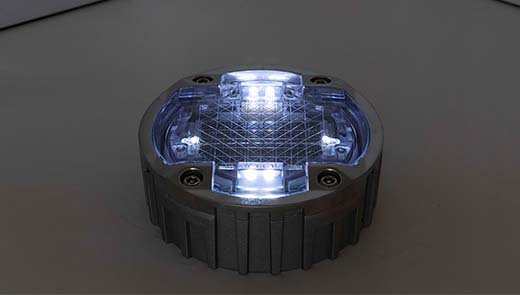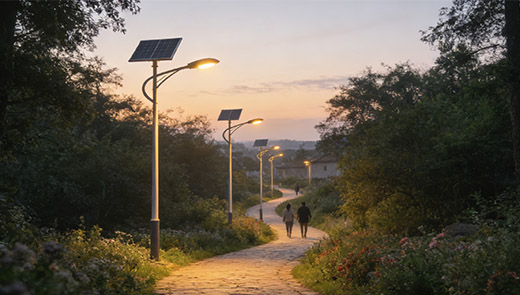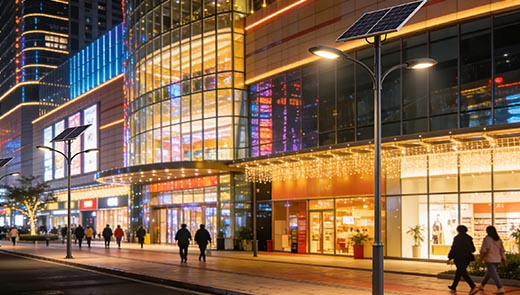How Tall Is A Street Light Pole?
The height of a street light pole may seem like a simple value, but it plays a crucial role in lighting effect, safety and security, environmental integration and other aspects. The purpose of this article is to discuss the height of street light poles, covering its importance, common height values, factors affecting the determination of height and other relevant considerations, for readers to fully analyze the learning behind the height of street light poles.
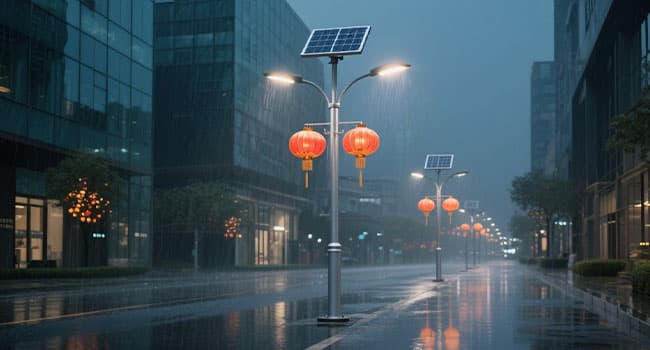
Why is the height of solar street light crucial?
Lighting coverage
The height of a street light directly determines the spread of light, and generally speaking, the higher the installation height, the wider the area covered by lighting. However, it should be noted that a higher installation height does not mean that the light intensity will be enhanced. The key lies in finding a balance between light intensity and coverage area. If streetlights are installed too low, the light will be concentrated in a small area, resulting in inadequate illumination of other areas. If they are installed too high, the light will be spread too thinly and will not adequately illuminate the target area.
Light distribution and intensity
The mounting height of a streetlight also affects the distribution of light. For areas that require bright, focused lighting, such as parking lots or highways, a higher mounting height (10 to 12 meters) is ideal, as it allows for an even distribution of light over the area for the safety of pedestrians and drivers. This height allows the light to be evenly distributed over the area for the safety of pedestrians and drivers. Lower mounting heights are more appropriate in areas such as residential gardens or sidewalks, where concentrated, localized lighting is needed.
Common street light pole heights
Different scenarios have different requirements for streetlight pole heights, here are some common scenarios for streetlight pole heights:
Residential areas
Street light poles are typically 12-15 feet tall, or about 4 meters. This height not only allows the light to cover the district roads, green belts and other areas, to protect the safety of residents traveling at night, but also to avoid the light is too high and too strong and directly hit the windows of residents, affecting the residents to rest, a good balance between the lighting needs and the comfort of living.
Highways
Street light poles are generally 20-30 feet, or 6-9 meters. Due to the high speed of vehicles on the highway, higher light poles can project light to a longer distance, so that drivers can see the road ahead, lane lines and possible obstacles in advance, to reduce traffic accidents due to lack of vision, providing a more reliable visual security for high-speed driving.
Commercial areas
Streetlight poles tend to be 15-25 feet in height, or 4.5-7.6 meters. Commercial areas, high traffic flow, this height of light can not only illuminate the sidewalks, stores in front of the area, convenient for pedestrians to shop, walk, but also allows vehicle drivers to clearly see the road pedestrians and vehicles, enhance the overall security of the commercial area, and enhance the customer's willingness to spend.
Large open spaces
Areas like stadiums and factories use streetlights called “high mast lights” that can reach heights of 60-150 feet, or about 18-45 meters. These areas are large and expansive, and with their superb height, high bay lights can project light over a wide area to evenly cover the entire site, meeting the need for large-scale lighting for large events, manufacturing operations, and so on, without the need for densely installed poles to achieve comprehensive lighting.
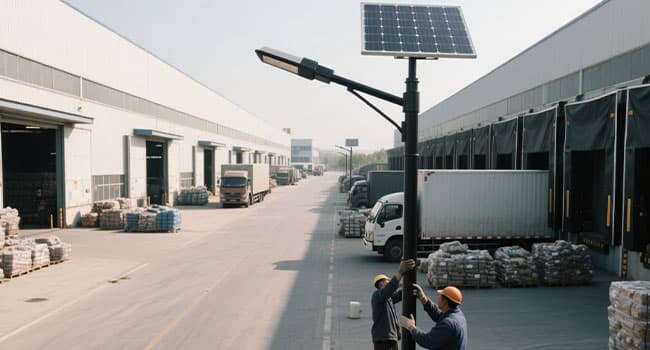
Factors determining the height of a street light pole
Lighting requirements
The main function of a street light is to provide adequate visibility for road users. Higher poles are able to distribute light over a wider area, which means that fewer poles are required to cover the same distance. However, the visibility requirements vary greatly from area to area. For example, campus roads need to take into account both pedestrians' reading and vehicular traffic, and the lighting requirements are meticulous; while remote rural roads can satisfy basic identification, so it is necessary to balance the coverage and light pollution with the characteristics of the area.
Energy efficiency
Modern LED streetlights can be mounted at slightly lower heights than conventional lighting while still providing adequate illumination, which is one of the reasons why energy efficient lighting solutions are becoming increasingly popular in Victorian councils. Low height installation reduces light transmission losses and saves electricity at the same level of brightness. For example, in some cities, when replacing traditional fixtures with LED streetlights in old neighborhoods, the reduced height still maintains the lighting effect and significantly reduces the electricity bill.
Safety considerations
The height of the street light has an impact on the safety of vehicles and pedestrians, too low street light may cause glare to the driver, especially in the rainy days, the ground reflections will make the glare more serious, interfering with the driving line of sight; and too high street light may not be able to adequately illuminate the sidewalks, pedestrians are prone to be tripped by the obstacles at night. Therefore, it is necessary to set the height accurately according to the road traffic flow and pedestrian density to balance the safety of both parties.
Aesthetics and environmental impacts
In historic areas or places with specific design requirements, the height of streetlights may be adjusted to blend with the surrounding architectural style, such as streets in ancient towns, where the height of streetlights will match the height of eaves of ancient buildings to avoid abruptness; in addition, environmental factors, such as the impacts on local wildlife, also influence the decision on the height of streetlights, such as the migration of birds. In addition, environmental factors, such as the impact on local wildlife, will also influence the street light height decision-making, such as near the migration routes of birds, the street light height will be reduced to minimize the interference of their navigation.
Other considerations for street light poles
Uniform spacing of street lights
The primary purpose of streetlights is to illuminate the roadway for pedestrians, bicyclists, and motorists, and uneven spacing of streetlights can lead to accidents if there is an area of bright light followed by darkness, so even spacing is critical to safety. Therefore, even spacing is essential for safety. The distance between two poles should be approximately 2.5-3 times the height of the pole, with shorter poles installed closer together. For example, a 4 meter high street light should be spaced about 10-12 meters apart to allow for a seamless flow of light and to avoid the visual discomfort of alternating light and dark.
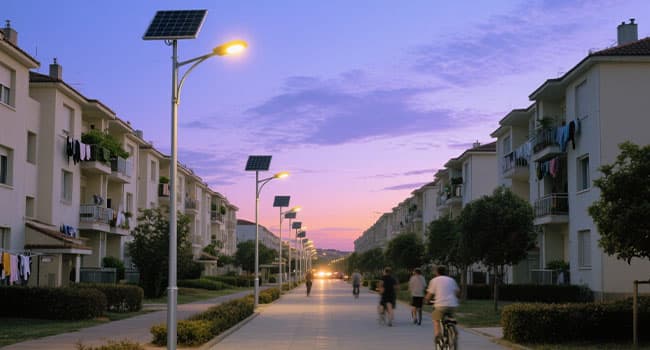
Installation environment
The installation area affects the type of light pole required. For example, in coastal areas, light poles should have a special coating to prevent corrosion from seawater, the salt carried by the sea breeze is highly corrosive, and ordinary light poles are prone to rust and damage. In typhoon areas, light poles should not only be the right height, but also thicken the pole, enhance the wind resistance, to ensure that the stability of standing in bad weather.
Light distribution
Even if the street lighting is good, trees or tall buildings and other obstacles may cause dark areas, which must be taken into account when planning the location of street lights. For example, roadside with dense sycamore trees on the road, summer foliage will block the light, the need to appropriately raise the height of the street lamp or adjust the position to ensure that the light can penetrate the foliage gap to illuminate the road.
The aesthetic value of street light poles
Nowadays, street light poles are not only functional, but decorative poles can also highlight the aesthetic features of statues, gardens, fountains and other aesthetic features, which add charm to ordinary urban spaces. In some cultural squares, street light poles will be designed in a retro shape with carved decorations, echoing the surrounding historical buildings. When lit up at night, the poles themselves become a landscape, enhancing the cultural atmosphere of the area.
Maintenance of street lights
An average LED street light runs for about 10 to 12 hours a day, with a bulb life of about 50,000 hours. To ensure lighting efficiency, it is important to replace the bulbs in a timely manner and make sure that the poles are sturdy enough to support the lamps and lanterns. Regularly check the joints and rustproof layer of the pole, for example, conduct a comprehensive overhaul of the pole once a year, so as to deal with problems such as looseness and corrosion in time and prolong its service life.
In summary, the height of the street light pole is an important issue that requires comprehensive consideration of various factors, which not only affects the lighting effect, energy efficiency and safety and security, but also closely related to aesthetics and environmental factors. Different scenes have different common height standards, and many factors together determine the specific street light pole height, at the same time, street light spacing, installation environment, light distribution, aesthetic value and maintenance should not be ignored. Choosing the right height of street light pole is important for realizing the best lighting effect, guaranteeing safety and harmonious coexistence with the environment.

